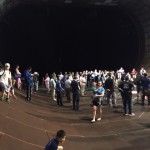NASA’s Ames Celebrates 75 Years of Excellence and ACE Played a (Okay, Very) Small Part
By Martha Sessums
NASA’s Ames Research Center was partying down this past Saturday. It was their 75th Anniversary Open House, and by noon Moffett Field was packed. But the kids, parents and the rest of the visitors gladly stood in long lines to tour the exhibits, including the International Space Station. Outside the tent, they took selfies or family shots with an 8-foot balloon astronaut.
Part of the fun was that Ames hasn’t been open to the public for 15 years, so it seemed that everyone was eager to explore and learn what’s in the big buildings we see as we drive past on the freeway. And, wow, it’s a lot!
Ames’ space science research looks for other planets that may support life, and have found rare galaxies that have no neighbors. Like, no other heavenly bodies near by for millions of miles. That’s lonely.
How about those microbial mats that are responsible for creating the oxygen-rich atmosphere we breathe. They look like primordial goo, but they can also live in rocks where grazing animals won’t munch on them.
Did you know Ames’ research helps commercial airplanes fly better in bad weather conditions? Or designs and tests landing materials, structures and systems so Rover on Mars and Space Station shuttles safely survive the speed and heat of landing or re-entry?
There are other ways Ames looks at our world. SOFIA’s infrared telescope mounted on a Boeing 747 flies above the earth taking pictures that sees the details of stars and galaxies unseen before.
Another team of scientists looks at the microscopic world of inorganic nanomaterials. These can assist in sensor performance, such as detecting E. coli in water.
And of course there’s the massive wind tunnel building hosting two tunnels that test how air speed and direction affects the design of airplanes, spacecraft and even trucks. I was lucky to tour inside the “small” wind tunnel that can test an aircraft with an 80-foot wing span, and imagined the difficulty of managing the power of wind, much less seeing and recording the results.
The booths covered the science, technology, engineering and math of Ames’ many missions and projects. It was a mass amount of STEM with capital letters. The crowds of excited, curious kids asking intelligent questions to the scientists reminded me that we live in an area that motivates deep learning.
Passing the Ames Administration building, I was also reminded that ACE was once an admittedly small part of the learning and teaching that takes place at Moffitt Field. ACE has served the Bay Area since 1968, originally delivering educational programs via closed circuit television over our FCC assigned radio spectrum. Classes were delivered to Ames scientists in the 1980s, and an Ames representative was once on ACE’s board.
Closed circuit television. So old school now. Today’s learning environment uses the Internet and is mobile and modular.
For 75 years, Ames has driven the education curve by leading research to discover new places and things, develop innovations and provide tested solutions. The hordes of kids streaming throughout the massive grounds absorbing everything that Ames was showing off was proof that science is cool, and Ames has got it.

